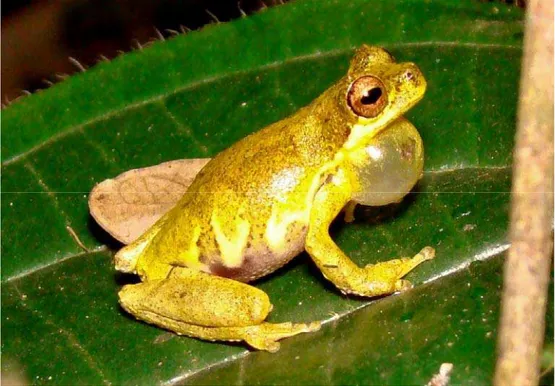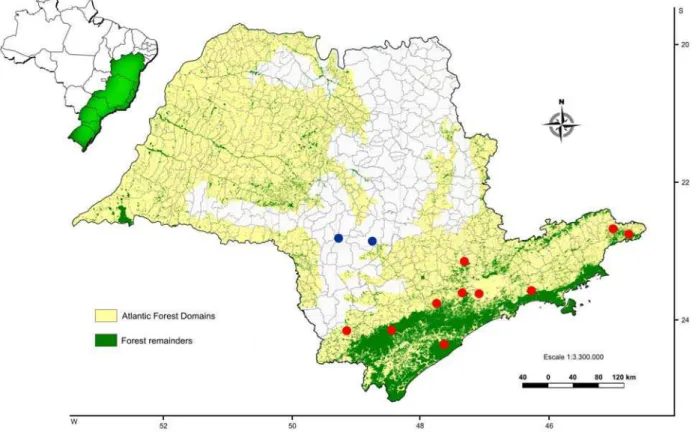Journal of Species Lists and Distribution
ISSN 1809-127X (online edition) www.checklist.org.br © 2009 Check List and Authors
NOTES ON GEOGRAPHIC DISTRIBUTION
Check List, Campinas, 5(4): 776–779, December, 2009. 776
Amphibia, Anura, Hylidae, Dendropsophus microps (Peters, 1872): Distribution extension
in state of São Paulo, Brazil and first record in Cerrado domain
Fábio Maffei,1 * Flavio Kulaif Ubaid,1 Silvio César de Almeida,1 Daniel Contieri Rolim,1 Domingos Geraldo Scarpellini-Jr.,1 Guilherme Marson Moya, 2 Elieth Floret Spirandelli-Cruz,1 and Jorge Jim 1
1
Universidade Estadual Paulista, Instituto de Biociências de Botucatu, Departamento de Zoologia. Distrito de Rubião Júnior s/n. CEP 18618-000. Botucatu, SP, Brazil.
2
Faculdade Anhanguera de Bauru,Curso de Ciências Biológicas. Avenida Moussa Nakhal 3-3. CEP 17021-005. Bauru, SP, Brazil.
*
Corresponding author. E-mail: maffei@ibb.unesp.br
Dendropsophus microps is a small frog (less than
30 mm SVL) described by Peters (1872), for individuals collected in Nova Friburgo, Rio de Janeiro state, Southeastern Brazil. The species belongs to the Dendropsophus parviceps group, which is now composed by 15 species (Faivovich et al. 2005).
According to Silvano et al. (2003) D. microps is typically restricted to the Brazilian Atlantic Forest. The known geographic distribution
reaches from the South of the Bahia state (Silvano and Pimenta 2001) to the North of the Rio Grande do Sul state (Kwet and Di-Bernardo 1999). It is also known to occur in the states of Minas Gerais (Haddad et al. 2008), Espírito Santo (Prado and Pombal Jr. 2005), Rio de Janeiro (Santos et al. 1998; Carvalho-e-Silva and Izeckshon 2001), Paraná (Conte and Rossa-Feres 2006, 2007) and Santa Catarina (Deiques et al. 2007; Woehl Jr. and Woehl 2008).
Notes on Geographic Distribution
Check List, Campinas, 5(4): 776–779, December, 2009. 777
In the state of São Paulo, specimens of this species were recorded in Campo Grande (Bokermann 1963), Estação Biológica de Boracéia (Heyer et al. 1990; Bertoluci and
Rodrigues 2002a), Parque Estadual Intervales (Bertoluci and Rodrigues 2002b), Estação
Ecológica Juréia-Itatins (Pombal Jr. and Gordo
2004), serra de Paranapiacaba (Pombal Jr. and Haddad 2005), Estação Ecológica do Bananal (Zaher et al. 2005), serra do Japi (Ribeiro et al. 2005), Cotia (Dixo and Verdade 2006), São José do Barreiro (Serafim et al. 2008), Tapiraí and Piedade (Condez et al. 2009).
Herein, we present two new localities for
Dendropsophus microps, broadening its
distribution towards the midwestern region of the state of São Paulo.
In field trips conducted between December 2005 and March 2007 in Recanto Ecológico
Sacae Watanabe, municipality of Botucatu
(22º59’34” S, 48º30’04” W; 890 m above sea level), individuals of D. microps were observed in a forest fragment, as well as in its borders and in an adjacent open field. The maximum abundance was recorded in December
and January, when 40 males were recorded in calling activity.
On 18 December 2007 in Rincão do Pinhal farm, municipality of Botucatu (22°59'36" S, 48°29'31" W, 824 m above sea level) at 20:00h (air temperature 23º C) one individual of
D. microps was recorded calling in a temporary
pond in a forest fragment, downstream from a great dam.
In 20 January 2009, about 19:00h (air temperature 21.5º C) of a rainy day (14.9 mm precipitation), five individuals of D. microps were observed calling (Figure 1) in a rain flooded area of forest. The visual and acoustic records were made near the Palmital river in the Rio Pardo II farm, municipality of Avaré (22°50'13" S, 48°58'33" W, 650 m above sea level). In the same location, one month later, ten individuals were recorded calling in bushes inside the forest. Two individuals were collected (JJ 7853 and JJ 7854) and deposited at the Jorge Jim Scientific Collection, housed at
Departamento de Zoologia, Instituto de
Biociências, UNESP - Campus de Botucatu, São
Paulo state, Brazil (License IBAMA/ICMBio - SISBIO 16778-1).
Notes on Geographic Distribution
Check List, Campinas, 5(4): 776–779, December, 2009. 778
The vegetal formation in these new areas of occurrence for the species is Cerrado (Brazilian savanna) with influence of Seasonal Semidecidual Forest (Fundação SOS Mata Atlântica and INPE 2008). These records are located in a transitional zone between the Cerrado and Atlantic Forest biomes, where different floras are in contact (IBGE 2004). In the municipality of Botucatu, the area is covered by different vegetal formations, including Seasonal Semidecidual Forest and different physiognomies of Cerrado. The Avaré record is in transitional areas of Seasonal Semidecidual Forest with larger influence Cerrado “sensu lato”.
All records of D. microps in the literature were made in areas of Atlantic Forest, more specifically in areas of moist forests in plateaus or coastal lowlands. The Ribeirão Branco record (Pombal Jr. and Haddad 2005) corresponded to the most interior locality in the state of São Paulo, at a distance of about 130 km from the coast. However, the record presented here for the municipality of Avaré broadens this distance to 260 km, and also presents the first record of D. microps outside Atlantic Forest domains in the São Paulo state (Figure 2).
————————————————
Acknowledgements: We thank to Conservation International Brazil, Duratex S.A. and Fundibio for research support, CNPq (to SCA, Proc. #141733/2006-3) for financial support and Sacae Watanabe for the reception and allowing fieldwork in the Recanto Ecológico Sacae Watanabe.
————————————————
Literature cited
Bertoluci, J. and M.T. Rodrigues. 2002a. Seasonal patterns of breeding activity of Atlantic Rainforest anurans at Boracéia, Southeastern Brazil. Amphibia-Reptilia 23: 161-167.
Bertoluci, J. and M.T. Rodrigues. 2002b. Utilização de habitats reprodutivos e micro-habitats de vocalização em uma taxocenose de anuros (Amphibia) da Mata Atlântica do sudeste do Brasil. Papéis Avulsos de Zoologia, São Paulo 42(11): 287-297.
Bokermann, W.C.A. 1963. Girinos de anfíbios brasileiros - 1 (Amphibia - Salientia). Anais da Academia Brasileira de Ciências 35: 465-474.
Condez, T.H., R.J. Sawaya and M. Dixo. 2009. Herpetofauna of the Atlantic Forest remnants of Tapiraí and Piedade region, São Paulo state, southeastern Brazil. Biota Neotropica 9(1): 157-185.
Conte, C.E. and D.C. Rossa-Feres. 2006. Diversidade e ocorrência temporal da anurofauna (Amphibia, Anura) em São José dos Pinhais, Paraná, Brasil. Revista Brasileira de Zoologia 23(1): 162-175. Conte, C.E. and D.C. Rossa-Feres. 2007. Riqueza e
distribuição espaço-temporal de anuros em um remanescente de Floresta de Araucária no sudeste do Paraná. Revista Brasileira de Zoologia 24(4): 1025-1037.
Deiques, C.H., L.F. Stahnke, M. Reinke and P. Schmitt. 2007. Guia ilustrado dos anfíbios e répteis do Parque Nacional de Aparados da Serra, Rio Grande do Sul, Santa Catarina, Brasil. Porto Alegre, USEB, 120 p. Dixo, M. and V.K. Verdade. 2006. Herpetofauna de
serrapilheira da Reserva Florestal de Morro Grande, Cotia (SP). Biota Neotropica 6(2): 1-20.
Faivovich, J., C.F.B. Haddad, P.C.A. Garcia, D.R. Frost, J.A. Campbell, and W.C. Wheeler. 2005. Systematic review of the frog family Hylidae, with
special reference to the Hylinae: phylogenetic analysis and taxonomic revision. Bulletin of the American Museum of Natural History (294): 1-240. Fundação SOS Mata Atlântica and INPE. 2008. Atlas
dos remanescentes florestais da Mata Atlântica: período 2000-2005. São Paulo: Fundação SOS Mata Atlântica e INPE (Instituto Nacional de Pesquisas Espaciais). 157 p.
Haddad, C.F.B., L.F. Toledo and C.P.A. Prado. 2008. Anfíbios da Mata Atlântica: guia dos anfíbios anuros da Mata Atlântica. São Paulo: Editora Neotropica. 244 p.
Heyer, W.R., A.S. Rand, C.A.G. Cruz, O.L. Peixoto, and C.E. Nelson. 1990. Frogs of Boracéia. Arquivos de Zoologia 31(4): 231-410.
IBGE (Instituto Brasileiro de Geografia e Estatística) 2004. Mapa de biomas do Brasil - escala 1:5.000.000. Eletronic Database accessible at http://www.ibge.gov.br. Captured on 22 January 2009.
Kwet, A. and M. Di-Bernardo. 1999. Pró-Mata - Anfíbios, Amphiben, Amphibians. Porto Alegre: Edipucrs. 107 p.
Peters, W.H.C. 1872. Uber eine Sammlung von Batrachiern aus New Freibourg in Brasilien. Monatsbericht der KöniglichpPreussischen Akademie der Wissenschaften zu Berlin, 1872: 680-684.
Pombal Jr., J.P. and M. Gordo. 2004. Anfíbios anuros da Juréia; p. 243-256. In O.A.V. Marques and W. Duleba (ed.). Estação Ecológica Juréia-Itatins. Ambiente físico, flora e fauna. Ribeirão Preto: Holos Editora.
Notes on Geographic Distribution
Check List, Campinas, 5(4): 776–779, December, 2009. 779
do Brasil. Papéis Avulsos de Zoologia, São Paulo 45(15): 201-213.
Prado, G.M. and J.P. Pombal Jr. 2005. Distribuição espacial e temporal dos anuros em um brejo da Reserva Biológica de Duas Bocas, sudeste do Brasil. Arquivos do Museu Nacional, Rio de Janeiro 63(4): 685-705.
Ribeiro, R.S., G.T.B.T. Egito, and C.F.B. Haddad. 2005. Chave de identificação: anfíbios anuros da vertente de Jundiaí da Serra do Japi, estado de São Paulo. Biota Neotropica 5(2): 1-15.
Santos, C.S., A.C.R. Alves and S.P.C. Silva. 1998. Description of the Tadpoles of Hyla giesleri and Hyla microps from Southeastern Brazil. Journal of Herpetology 32(1): 61-66.
Serafim, H., P.J.P. Cicchi, S. Ienne and J. Jim. 2008. Anurans of remnants of Atlantic forest of São José do Barreiro municipality, São Paulo state, Brazil. Biota Neotropica 8(2): 69-78.
Silvano, D.L. and B.V.S. Pimenta. 2001. Geographic Distribution. Hyla microps. Herpetological Review 32(4): 271.
Silvano, D.L., G.R. Colli, M.B.O. Dixo, B.V.S. Pimenta and H.C. Wiederhecker. 2003. Anfíbios e Répteis; p. 183-200 In D.M. Rambaldi and D.A.S. Oliveira (ed.). Fragmentação de Ecossistemas: Causas, efeitos sobre a biodiversidade e recomendações de políticas públicas Brasília: Ministério do Meio Ambiente/Secretaria de Biodiversidade e Florestas. Woehl Jr., G. and E.N. Woehl. 2008. Anfíbios da Mata
Atlântica. Jaraguá do Sul: Instituto Rã-bugio para Conservação da Biodiversidade. 61p.
Zaher, H., E. Aguiar, and J.P. Pombal Jr. 2005. Paratelmatobius gaigeae (Cochran, 1938) re-discovered (Amphibia, Anura, Leptodactylidae). Arquivos do Museu Nacional, Rio de Janeiro 63(2): 321-328.
Received: September 2009 Revised: September 2009 Accepted: September 2009 Published online: October 2009

